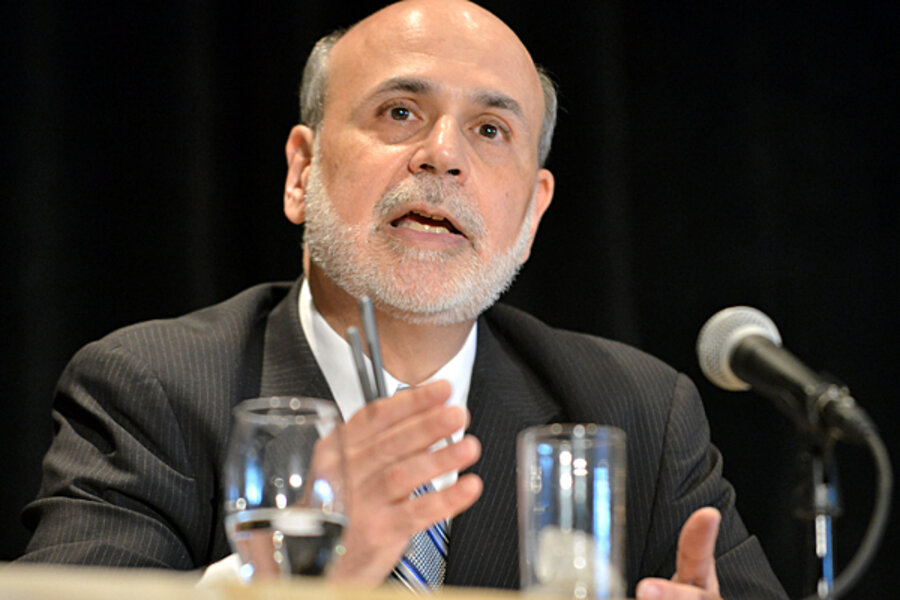Bernanke speaks, markets jump (both up and down). Are Fed's signals working?
Loading...
Fed talk isn’t cheap, and the Federal Reserve has been doing a lot of talking lately.
On Thursday, words from Fed Chairman Ben Bernanke pushed stock prices up and bond interest rates substantially down. His statements, in a late-Wednesday speech, were crafted to reassure investors that the central bank sees the need for a continuation of stimulative monetary policies.
But three weeks before, Mr. Bernanke had done just the opposite. On June 19, he rattled Wall Street with words that investors translated as “the end is near” for that economic stimulus.
Welcome to the new, more transparent Federal Reserve – and to the challenge of describing a policy outlook that’s both murky and not very easy to digest.
As chairman, Bernanke has ramped up efforts to make America’s central bank communicate more clearly and more frequently with the public. But those efforts have yielded mixed results, sometimes appearing to leave investors more confused than enlightened. Lately, the task has been complicated because the US economy is both in a tough patch – with slow growth and relatively high unemployment – and improving enough that many Fed officials believe it’s important to signal that they’ll have to “taper” the monetary stimulus at some point.
The episodes of the past three weeks give the impression of a Fed that’s talking a lot, but not clearly enough. Or, perhaps worse, that Fed officials feel compelled to reframe a message due to an initial frosty reception by financial markets.
The June 19 comments caused the Standard & Poor’s 500 stock index to fall nearly 4 percent in two days. That dive was followed by a flurry of public recalibrating by Fed officials.
James Bullard, president of Federal Reserve’s regional bank in St. Louis, went so far as to openly question the wisdom of the Fed’s policy committee (on which he sits) in sending Bernanke forth with his June 19 message.
“The Committee’s decision to authorize the Chairman to lay out a more elaborate plan for reducing the pace of asset purchases was inappropriately timed,” Mr. Bullard said in a June 21 statement. The bond purchases he referred to, along with ultra-low interest rates, have become core tools in the Fed’s effort to revive economic growth since the recession.
Bullard explained his view by noting that the policy committee on that day was marking down its outlook for both economic growth and inflation, “yet simultaneously announcing that less accommodative policy may be in store.”
Some critics of the Bernanke Fed say the emphasis on communication and transparency is backfiring – not just on June 19 but in general.
“Silence is golden,” a New York Sun editorial said, arguing that the Fed should return to a traditional view that central banks should largely let their actions do the talking.
For his part, Bullard argues that the Fed should be wary of verbal signals that could be viewed in financial markets as tying policy changes to a calendar (rather than to shifts in economic conditions). Bernanke has emphasized that policy shifts will hinge on conditions in the economy, but he has also deployed some calendar dates – hinting in June that a scaling back of bond purchases could start as early as this fall.
Others laud Bernanke’s transparency efforts – symbolized by holding press conferences after some policy meetings – despite the risk of message flip-flops.
For one thing, the press conferences arguably score public-relations points for an institution that is very powerful, yet that is often criticized and can seem far removed from public accountability or oversight.
Whatever the right level of communication, the S&P 500 stock index on Thursday had rebounded to roughly where it stood before Bernanke made his June 19 remarks.
His latest comment, made July 10, is that the US economy appears likely to need a "highly accommodative monetary policy for the foreseeable future."
But how much has been settled by the recent rounds of “taper talk” by the Fed?
Not much, perhaps. What Bernanke said on July 10 isn’t necessarily inconsistent with what he said on June 19. Note that Fed policy can be “highly accommodative” even after the Fed starts to trim its monthly bond purchases.
And Fed policymakers have been consistent in saying that they’ll start to review the near-zero level of short-term interest rates once the unemployment rate falls to 6.5 percent.
Bottom line: Fedspeak is a tricky business, and it’s likely to keep moving markets – in both directions.









